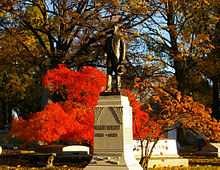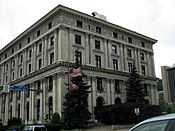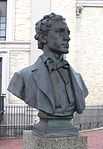Edmond Thomas Quinn


Edmond Thomas Quinn (1868, Philadelphia, Pennsylvania – September 1929, New York City) was an American sculptor and painter. He is best known for his bronze of Edwin Booth as Hamlet, which stands at the center of Gramercy Park in New York City. His over-lifesize bronze bust of Victor Herbert stands near The Pond in Central Park, New York City.
Education
He studied painting at the Pennsylvania Academy of Fine Arts under Thomas Eakins. Following Eakins's February 1886 forced-resignation from PAFA, Quinn followed him to the Art Students League of Philadelphia, and later became that short-lived school's curator.[1] In Paris he trained for a time as a sculptor in the studio of Jean Antoine Injalbert.
Career
He exhibited regularly at the National Academy of Design, showing paintings in 1891, 1893, 1905, 1906 and 1907. He first showed his sculpture there in 1908, and annually for many years, usually portrait busts. He won a silver medal for his sculpture at the Panama-Pacific Exposition, San Francisco, 1915.[2] He also exhibited at the Pennsylvania Academy of Fine Arts (1891), and the Art Institute of Chicago.
He was elected an Associate of the National Academy of Design in 1920,[3] and was a member of the National Sculpture Society,[4] the Century Association, the American Academy of Arts and Letters, and the Players Club, for whom he executed his statue of Booth.
Quinn was recognized as being a fine portraitist whose work "shows taste and conscience." His portrait busts include Franklin Hooper, Sylvester Malone, Edwin Markham, Vicente Blasco Ibáñez, Padraic Colum and Eugene O'Neill.[5] His half-length, oil-on-canvas portrait of Attilio Piccirilli, the sculptor whose studio executed many works of American Beaux-Arts masters, is in the National Academy of Design.[6] The National Portrait Gallery has a large number of his portrait busts.
Quinn was found drowned off Governors Island, New York City in September 1929, a suicide.[7] Quinn had tried to kill himself four months earlier by drinking poison.[8]
Quinn's papers are at Yale University.[9]
Selected works
Paintings
- Clown (oil on canvas, 1895), La Salle University Art Museum, Philadelphia, Pennsylvania.[10]
- Portrait of Attilio Piccirilli (oil on canvas, 1911), National Academy of Design, New York City.[11]
- Portrait of Sherry E. Fry (oil on canvas, 1915), National Academy of Design, New York City.[12]
- Portrait of Furio Piccirilli (oil on canvas, 1919), National Academy of Design, New York City.[13]
Sculptures
- Harry Wright Monument, West Laurel Hill Cemetery, Bala Cynwyd, Pennsylvania (1897).[14] Harry Wright was an early manager of the "Philadelphia Quakers," which became the Philadelphia Phillies.
- William Howard (Portrait of a Seated Man), Howard Memorial Cathedral (Masonic), Williamsport, Pennsylvania (1905).[15][16]
- Bas reliefs for Battle Monument, Kings Mountain National Military Park, South Carolina (1908).[17]
- Bust of Edgar Allan Poe, Poe Cottage, Bronx, New York (1908).[18]
- Zoroaster (Persian Religion and Philosophy), Brooklyn Institute of Arts and Sciences, Brooklyn, New York (1909–10).[19] This architectural sculpture is approximately 12 feet (3.65 m) tall.
- Architectural sculpture, Pittsburgh Athletic Association, Pittsburgh, Pennsylvania (1911), Benno Janssen, architect.
- Figure of a Nymph, Metropolitan Museum of Art, New York City (1912).[20]
- Relief bust of J. Edward Swanstrom, Columbus Park, Brooklyn, New York (1912).
- Bust of General Winfield S. Featherston, Vicksburg National Military Park, Vicksburg, Mississippi (1915).[21]
- General John C. Pemberton Monument, Vicksburg National Military Park, Vicksburg, Mississippi (1917).
- Edwin Booth as Hamlet, Gramercy Park, New York City (1918). Commissioned by the Players Club, whose clubhouse had been Booth's house.
- Bust of Professor Franklin W. Hooper, Brooklyn Museum, Brooklyn, New York (1920).[22]
- Victory, World War I Memorial, Faneuil Park, New Rochelle, New York (1921), Louis R. Metcalfe, architect.[23]
- Bust of Eugene O'Neill, National Portrait Gallery, Washington, DC (1922).
- Bust of Leon Kroll, Whitney Museum of Art, New York City (1924).[24]
- Bust of Victor Herbert, Central Park, New York City (1927).
- Bust of James McNeill Whistler (1928).
- Bust of Dr. J. Marion Sims, South Carolina Statehouse, Columbia, South Carolina (1929), Harold Sterner, architect.[25][26]
- Henry Clay, Smithsonian American Art Museum, Washington, DC (1929–30). Completed by Francis Herman Packer.[27]
- Bust of Frederick Dana Marsh, Rensselaer Polytechnic Institute, Troy, New York, (year).
Hall of Fame for Great Americans
- Bust of Edwin Booth (1926), Hall of Fame for Great Americans, Bronx, New York.[28]
- Bust of James Kent (1926), Hall of Fame for Great Americans, Bronx, New York.[29]
- Bust of Oliver Wendell Holmes (1929), Hall of Fame for Great Americans, Bronx, New York.[30]
- Bust of John Quincy Adams (1930, posthumously unveiled), Hall of Fame for Great Americans, Bronx, New York.[31]
-

Harry Wright Monument (1897), West Laurel Hill Cemetery, Bala Cynwydd, Pennsylvania.
-

Pittsburgh Athletic Association (1911), Pittsburgh, Pennsylvania.
-
Victor Herbert (1927), Central Park, New York City.
-

Edwin Booth (1926), Hall of Fame for Great Americans, Bronx, New York City.
-
Dr. J. Marion Sims (1929), Columbia, South Carolina.
References
- Sources
- Dearinger, David Bernard. Paintings and Sculpture in the Collection of the National Academy of Design 2004:455.
- Notes
- ↑ Margaret McHenry, Thomas Eakins Who Painted (Oreland, PA: by the author, 1946), p. 121.
- ↑ American Art Annual, 14 (1918): "Who's Who in Art": s.v. "Quinn, Edmond T., 135 De Kalb Ave., Brooklyn, N.Y."".
- ↑ "14 Elected to National Academy" New York Times (April 16, 1920)
- ↑ National Sculpture Society, ‘’Exhibition of American Sculpture Catalogue’’, National Sculpture Society, NY 1923 pp. 202-203
- ↑ Taft, Lorado, ‘’The History of American Sculpture’’, The Macmillan Company, New York, 1925 p 551.
- ↑ It is illustrated in Dearinger 2004:455
- ↑ "Body of E.T. Quinn Identified by Friend; Sculptor Who Ended His Life in Bay Will Be Buried Today at Newport" New York Times (September 14, 1929)
- ↑ "Quinn, Sculptor, Tries to End Life; Noted Artist Drinks Poison in His Home and Is Taken to Hospital. Motive Mystifies Family; His Bust of Holmes Unveiled in the Hall of Fame Last Week-- Has Work in Museum" New York Times (May 12, 1929)
- ↑ Edmond T. Quinn Papers
- ↑ Clown from La Salle University.
- ↑ Atilio Piccirilli from SIRIS.
- ↑ Sherry E. Fry from SIRIS.
- ↑ Furio Piccirilli from SIRIS.
- ↑ Wright Monument from FindAGrave.
- ↑ William Howard (Portrait of a Seated Man) from SIRIS.
- ↑ Howard statue from SearchForAncestors.
- ↑ King Mountain reliefs from SIRIS.
- ↑ Copy of Poe bust from Flickr.
- ↑ Persian Religion from Brooklyn Museum.
- ↑ Nymph from Metropolitan Museum of Art.
- ↑ General Featherston from NPS.
- ↑ Professor Hooper from Brooklyn Museum.
- ↑ World War I Memorial from The New Rochelle Report.
- ↑ Leon Kroll from SIRIS.
- ↑ Dr. Sims from SIRIS.
- ↑ Sims Monument from South Carolina Statehouse.
- ↑ Henry Clay from SIRIS.
- ↑ Edwin Booth
- ↑ James Kent
- ↑ Oliver Wendell Holmes
- ↑ John Quincy Adams
External links
 Media related to Edmond Thomas Quinn at Wikimedia Commons
Media related to Edmond Thomas Quinn at Wikimedia Commons
|

